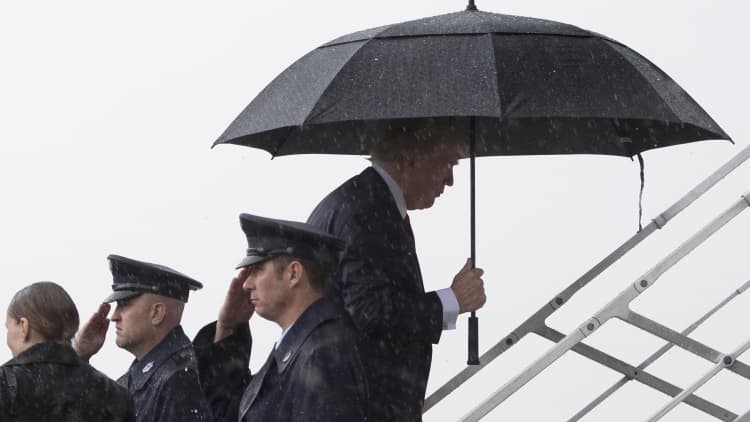
The "Trump trade" narrative is dying in the stock market.
The election of President Donald Trump and a Republican-majority in Congress was supposed to lead to Obamacare's end, tax reform, deregulation, an infrastructure build-out and a healthy increase in inflation accompanied by a rise in long-depressed interest rates.
But after the failure of Trump's Obamacare replacement at the end of last month followed by a weaker-than-expected jobs report Friday, the market clearly has its doubts about this premise.
Let's take the Trump trade point by point and see where it stands in the market's eyes.
1. Health-care reform — market saying, "Not likely"
On March 24, House Speaker Paul Ryan and Trump pulled the Republican bill after failing to win votes from the farther-right faction of the party. But Ryan was back this week proposing a new version of the bill that addresses persons with pre-existing conditions.
Does the market think he has a chance?
Take a look at a chart of Universal Health Services, an operator of acute care and behavioral health facilities which makes it among the most vulnerable health-care stocks if Obamacare goes away and a more strict Republican plan wins.
The stock has steadily climbed back to near where it was before the election. It would be going down if investors thought the Republicans had a chance.
2. Reflation — market saying, "Maybe"
The 10-year Treasury yield is back to levels not seen since just after Trump was elected. The decline has occurred even after the Fed raised rates last month. If investors really believed that Trump's plans are happening and that they will unleash a second-half economic growth boom, investors would be selling Treasurys and boosting that yield.
3. Infrastructure plan — market saying, "Maybe"
The market got excited a bit last week when it was reported Trump may be moving up his infrastructure plans and linking them to tax reform. But other than referencing this week a strange flow chart describing the process for getting a government building project approved, he has said little in detail about the plan, which officials have said will total $1 trillion.
If investors thought infrastructure was happening this chart of Martin Marietta, a maker of heavy building materials, would be pointing higher, but instead it has been stalling since January.
4. Tax reform — Market saying, "Maybe"
After the health-care debacle, investors are starting to doubt whether tax reform will happen in this year or at all. It didn't help when Ryan said this week that the two chambers of Congress and the White House are currently farther apart on tax reform than they were initially on the health-care plan that ultimately failed.
Still, many investors believe Trump and Congress can mess up many parts of tax reform as long as they get the part right about lowering the repatriation tax for companies with big stashes of foreign profits overseas.
Strategas Research Partners is keeping a great list of the companies that stand to benefit the most from a repatriation tax because of the amount of foreign cash they have relative to their market capitalization. The mock portfolio is still up since the election but the chart below shows that it is in a serious downtrend and back to levels where it started the year.
Source: Strategas Research Partners
It shows doubt that even a repatriation tax break can get done.
5. Deregulation — market saying, "Probably"
No one will benefit more from possible financial deregulation than the regional banks, who have had to devote a significant part of their relatively smaller resources to compliance. The SPDR S&P Regional Banking ETF is still up big since the election, but it is well off the all-time high reached at the end of last month.
And as far that wall on the border with Mexico? Even the Mexican Peso has given up most of its losses since the election. (Chart below is the U.S. dollar vs the MXN, so lower value means peso gaining in value.)
So that's where we are as far as the "Trump trade" is concerned.
So where are we headed?
The catch is that the Trump trade can fail and the market can still do OK if one thing happens: earnings grow.
"The combination of planned tax cuts (both corporate and personal), light-handed regulation, a repatriation tax holiday on overseas cash and possible infrastructure spending has buoyed hopes for faster economic activity in 2H17 into 2018. However, earnings have been more crucial for stock prices," wrote Tobias Levkovich, Citigroup's chief U.S. equity strategist, in a note to clients Friday.
First-quarter earnings season kicks of with the major banks on Thursday. Right now, analysts expect the S&P 500 to post 9.9 percent earnings growth for the period, according to S&P Global Market Intelligence.
Citigroup predicts 9 percent earnings growth for the full year, but admits a portion of that is banking on lower tax rates coming in the fourth quarter. That kind of earnings growth will justify the trailing P/E of 22 currently for the index, which is above a five-year average of 18.
Bottom line: If we get this kind of earnings growth, it validates the market at current levels, but for stocks to keep going the president needs to revive the Trump trade by taking action that indicates that at least tax reform is on the way before the year is out.
Watch: Defense stocks rally following Syria airstrikes



